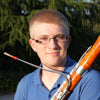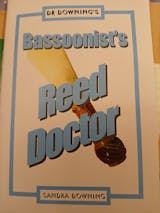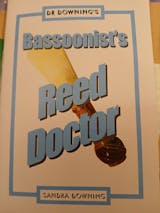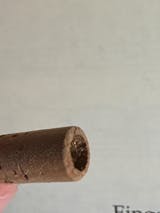One must begin with an explanation of what posture is: “Posture is the position in which you hold your body against the effects of gravity, and the term applies whether one is sitting, standing, or assuming any position.” (Dawson, 2010)
When playing or indeed during normal life it is important to carry out tasks / playing whilst using a good posture. Good posture is a term I will use throughout this article with the following meaning attached to it, a posture in which you strive to attain your body's most natural & free posture. The reasons we should strive to use a good posture in physical terms is to avoid unnecessary strain, stress & injury. At the same time this prevents fatigue by allowing the body to use less energy when performing. For woodwind players, including bassoonists, there is a second musical advantage in that it leads to being able to breathe deeper which can greatly improve tone quality. Simply put, "Every second spent practicing with poor posture is a second closer to back problems.” (Dean, 2008). It is important to note that “Posture is not a single position and is not a static thing; it’s dynamic, changing constantly as our body positions change” (Dawson, 2010),allowing you the freedom to move in and out of the main posture you use for each task.
For the sake of helping us look objectively at the support systems available for the bassoon we will assume that we have a chair that promotes good posture; the height allows for the hips to be higher than the knees and the chair slants forward with a suitable backrest as shown in diagram 1a (left). In the diagram the green arrow signifies the hips rotating, due to the slanted chair, so that the sitting bones ( ischial tuberosities) are in contact with the seat and the red arrow shows the body’s centre of gravity falling onto the sitting bones. The last assumption we will make, is that the bassoonist will “bring the instrument to [his or her] correctly positioned body, not vice versa” (Dawson, 2007). This sums up to promote good posture.
The bassoon initially began as a fairly light instrument in the Baroque era with fairly little keywork meaning that it often used to be played without any support. More recently lots of keywork has been added and the thickness of the bassoons bore increased leading to professional bassoons often weighing in at 3.4Kg (weight of Moosmann 222 bassoon). Due to the modern bassoons weight & the majority of its work being orchestral playing, it is mostly played sitting down. Posture is always important however “Sitting in any posture puts greater pressure[, compared to when standing,] on the intervertebral disks” (Watson, 2009) so maintaining a good posture becomes even more important for the bassoonist. A recent study by Paula Brusky found that out of a study of 166 bassoonists concluded that “Eighty-six percent of participants … reported PRMDs [performance-related musculoskeletal disorders].” (Brusky, 2009)
There are a variety of different support systems available when playing bassoon sitting down. Most of these support systems have been developed very recently, when bassoonists began to understand the importance of having a good playing posture.
Bassoon Neck Strap
Initially, the main (and possibly only) form of support for the bassoon was a neck strap and thus, out of habit it has stayed in use by quite a few players when sitting down. The neck strap attaches to a loop about two fifths the way up the bassoon and the neck piece sits on the back of the neck, putting most of the weight of the bassoon on the cervical vertebrae. Neck straps are adjustable so the bassoon can be raised as necessary to ensure the instrument is in an ergonomic position. The main advantage neck straps afford is the freedom of movement they allow. In posture terms this is great for the bassoonist allowing them to dynamically change their position. Unfortunately, neck straps can lead to a lot of postural issues. When you have the weight of the bassoon pulling on just your neck over a small surface area it can lead to the neck being pulled forward and right, as can been seen in the picture (left). The neck tries to compensate for this extra load and it “may lead to excessive neck/shoulder muscle overuse” (Dawson, 2009) “and can cause excess tension, as well as constriction of the breath.” (Skolnick, 2000. accessed 2014) This effect can be noticed on many older / more traditional bassoonists. The extra load on the neck also lead to a “pinched nerve in the neck” (Brusky, 2009) which could end a bassoonists career. Ideallyit seems it would be best to use another support system as the postural issues this strap may cause are great. If a neck strap had to be used it would be suggested that “frequent short rests should be inserted into practice sessions” (Watson, 2009)so that your back can recuperate and you could try using a neck strap with a larger neck piece to spread the weight of the bassoon over a larger area.
Bassoon Harnesses
A much lesser used support system is the bassoon harness which spreads the weight more equally across most of the back (see figure 1b). Bassoon harnesses are highly adjustable allowing most positions to be achieved and as they do not put any pressure on the neck, allow the neck area to be nearly tension free. The main problem for the bassoonist is that it constricts the movement of the rib cage and shoulder blades slightly, leading to shallower breaths, which could affect the tone quality reduced and restricted arm movement which could possibly lead to problematic playing positions. It is important to note that the weight of the bassoon will pull the back forward and right. Although, this is only likely to be to a small extent due to the weight being spread across most of the back it is “important to minimize the deviation of the vertebral column from the normal position as much as possible” (Watson, 2009). I can see no possibilities for further development of bassoon harnesses to resolve theses postural issues.
Bassoon Seat Straps
Bassoon seat straps in recent years have become extremely popular for use when sitting. A seat strap is a strap of material that you sit on with either a hook that fits into an eyelet on the bottom of the bassoon or a boot cup which fits onto the bottom of the bassoon (the boot joint of the bassoon). The “right thigh acts as a pivot-point with the bassoon resting against it” (Marsden, 2013. Accessed 2014) allowing you to move the bassoons position slightly mid performance by moving your right leg. You can then change how close the bassoon is to you and its height very easily. This is a very useful feature as not everybody or their bassoons are the same; this dexterity allows the most ergonomic position to be found. No weight is applied to the back or neck with this strap as the seat strap itself holds most of the bassoons weight and this allows the bassoonist to retain good back posture and thus allowing for a tension free back and shoulders. The only downside to this strap is that a lot of the bassoons horizontal weight, as the bassoon is played so that it tilts forward, is applied to the left hand. This can lead to a lot of tension building up in the fingers and forearm.
Bassoon Spike
Lastly, the bassoon spike as been used by some very notable bassoonists. The spike is welded onto the boot joint of the bassoon on the closest side to the bassoonist when playing. The spike again allows for good back posture however has the same issues regarding the weight of the bassoon on the left hand as the seat strap. William Waterhouse (pictured left) was a pioneer in bassoon posture and Alexander technique for the bassoon. He had “fitted his bassoon with a spike (much like a cello end pin), and has rebent his bocal. With this set up he is able to sit up straight while keeping his arms and shoulders low and relaxed” (Skolnick, 2000. Accessed 2014).As you can see this setup works very well for some players however the spike doesn’t afford much movement; “I like to move a bit naturally when I play and this peg/spike kept me firmly rooted to one position.” (Leech, 1999. Accessed 2014)
Conclusion
From this research it seems that every type of support system for the bassoon has its downsides and no one form of support stands out as being the strap to use when sitting down. It is however of my opinion that the bassoon seat strap is the most versatile of the supports available. Allowing the bassoonist with the aid of some very recent developments to be in a posture that allows for the most tension free posture and as such the best posture. “[Bassoonists] should rely primarily on seat straps while sitting” (Dawson, 2009)
Bibliography
Websites
Leech, A. (1999). Help for the Standing Bassoonist. Available: http://www.idrs.org/publications/controlled/DR/DR... Last accessed 14th Jan 2014.
Skolnick, H. (2000). Reflections on the Master Class for Bassoonists given by William and Elisabeth Waterhouse at the "Haus Marteau" in Lichtenberg, West Germany. Available: http://www.idrs.org/publications/controlled/DR/DR... Last accessed 14th Jan 2014.
Articles
Brusky, P. (2009). High Prevalence of Performance-related Musculoskeletal Disorders in Bassoon Players. Medical Problems of Performing Artists . 24 (2), p81-82.
Dawson, W. (2007). Ask the Doctor: Getting Back to Music (Rehabilitation) – Part Two. The Double Reed. 30 (1), p89.
Dawson, W. (2009). Ask the Doctor: When Making Music Becomes Painful. The Double Reed. 32 (2), p115.
Dawson, W. (2010). Ask the Doctor: Is Posture Really That Important?. The Double Reed. 33 (4), p149.
Dean, M. (2008). Your Back Has Supported You for Years: It's Time to Give It Some Support in Return. International Musician. 106 (5), 12.
Books
Klickstein. (2009). Injury Prevention, II. In: . The Musician's Way: A Guide to Practice, Performance, and Wellness . New York: Oxford University Press. p254.
Watson, A. (2009). Posture and the Back in Musical Performance. In: . The Biology of Musical Performance . Maryland, USA: The Scarecrow Press, Inc. p26, 34.
This Article Was Written / Collated By
|
|
Bassoonist at Crook and Staple |




